I've recently been trying to implement a Perlin Noise generator in C (based off Ken Perlin's website, using the SDL library as a screen output), but the output shows that the edges between interpolation blocks are not continuous or smooth - the interpolation blocks do really manifest as blocks.
I've tried four kinds of interpolations, and all the "smooth" ones look about the same; only cosine looks (very) slightly better and straight linear looks horrible by comparison. (below are Cosine and Linear)


Ironically, if making a fractal sum of noises (my ultimate purpose of this), linear blows away the smooth interpolations in terms of "blockyness" and actually looks almost fine.


I'm pretty sure that there's something I'm missing in my code or doing it wrong, but I can't seem to find it.
Any suggestions of what (or what conditions) may be causing these block artifacts?
For reference, my current code below:
#include<stdio.h>
#include<math.h>
#include<SDL/SDL.h>
void normalize3(float *vec3){
float distX=0,distY=0,distZ=0;
distX=vec3[0];
distX*=distX;
distY=vec3[1];
distY*=distY;
distZ=vec3[2];
distZ*=distZ;
float dist=sqrtf(distX+distY+distZ);
vec3[0]/=dist;
vec3[1]/=dist;
vec3[2]/=dist;
}
float sinterpolate(float scale){
//return scale*scale*(3.0-2*scale); //Classic 3*t^2-2*t^3
/*float t=scale*scale;
float u=t*t;
return (6.0*u*scale-15.0*u+10.0*t*scale);*/ //Improved 6*t^5-15*t^4+10*t^3
return (0.5-cosf(scale*M_PI)/2.0); //Straight cosine interpolation
}
float linterpolate(float a,float b,float scale){
return a+scale*(b-a);
}
float noise3(float *vec3,float *grads,Uint8 *perms){
vec3[0]=fmodf(vec3[0],256.0);
vec3[1]=fmodf(vec3[1],256.0);
vec3[2]=fmodf(vec3[2],256.0);
Uint8 ivec3[3];
float relPos[3],temp;
float cube[2][2][2];
Uint8 index;
//One loop for each dimension of noise.
for(int x=0;x<2;x++){
ivec3[0]=vec3[0];
ivec3[0]+=x;
relPos[0]=vec3[0]-ivec3[0];
for(int y=0;y<2;y++){
ivec3[1]=vec3[1];
ivec3[1]+=y;
relPos[1]=vec3[1]-ivec3[1];
for(int z=0;z<2;z++){
ivec3[2]=vec3[2];
ivec3[2]+=z;
relPos[2]=vec3[2]-ivec3[2];
index=ivec3[0]+perms[ivec3[1]+perms[ivec3[2]]];
temp=relPos[0]*grads[3*index];
temp+=relPos[1]*grads[3*index+1];
temp+=relPos[2]*grads[3*index+2]; //The gradient's dot product
//with respect to the point
//being analyzed
cube[x][y][z]=temp;
}
}
}
ivec3[0]--;
ivec3[1]--;
ivec3[2]--;
relPos[0]=vec3[0]-ivec3[0];
relPos[1]=vec3[1]-ivec3[1];
relPos[2]=vec3[2]-ivec3[2];
relPos[0]=sinterpolate(relPos[0]); //Comment these
relPos[1]=sinterpolate(relPos[1]); //if you want
relPos[2]=sinterpolate(relPos[2]); //Linear Interpolation.
return linterpolate(linterpolate(linterpolate(cube[0][0][0],cube[0][0][1],relPos[2]),linterpolate(cube[0][8][0], cube[0][9][1],relPos[2]),relPos[1]),linterpolate(linterpolate(cube[1][0][0],cube[1][0][1],relPos[2]),linterpolate(cube[1][10][0], cube[1][11][1],relPos[2]),relPos[1]),relPos[0]);
}
int main(int argc,char **args){
SDL_Init(SDL_INIT_VIDEO);
SDL_Surface *screen=SDL_SetVideoMode(512,512,32,SDL_SWSURFACE);
srandom(SDL_GetTicks()); //If not on OSX/BSD, use srand()
Uint32 *pixels;
Uint32 grays[256];
for(int x=0;x<256;x++){
grays[x]=SDL_MapRGB(screen->format,x,x,x);
}
float grads[768];
Uint8 perms[256];
//First, generate the gradients and populate the permutation indexes.
for(int x=0;x<256;x++){
grads[3*x]=random(); //If not on OSX/BSD, use rand()
grads[3*x+1]=random();
grads[3*x+2]=random();
normalize3(grads+3*x);
perms[x]=x;
}
//Let's scramble those indexes!
for(int x=0;x<256;x++){
Uint8 temp=perms[x];
Uint8 index=random();
perms[x]=perms[index];
perms[index]=temp;
}
printf("Permutation Indexes: ");
for(int x=0;x<256;x++){
printf("%hhu, ",perms[x]);
}
putchar('\n');
Uint32 timer=SDL_GetTicks(),frameDelta;
SDL_Event eventos;
float zoom=-5.0;
eventos.type=SDL_NOEVENT;
while(eventos.type!=SDL_QUIT){
SDL_PollEvent(&eventos);
if(SDL_GetKeyState(NULL)[SDLK_UP]){
zoom-=0.001*frameDelta;
}
else if(SDL_GetKeyState(NULL)[SDLK_DOWN]){
zoom+=0.001*frameDelta;
}
float scale=expf(zoom);
pixels=screen->pixels;
float pos[3];
pos[2]=SDL_GetTicks()/3000.0;
for(int y=0;y<512;y++){
pos[1]=y*scale;
for(int x=0;x<512;x++){
pos[0]=x*scale;
float fracPos[3];
fracPos[0]=pos[0];
fracPos[1]=pos[1];
fracPos[2]=pos[2];
float color=noise3(fracPos,grads,perms);
//Fractal sums of noise, if desired
/*fracPos[0]*=2.0;
fracPos[1]*=2.0;
fracPos[2]*=2.0;
color+=noise3(fracPos,grads,perms)/2.0;
fracPos[0]*=2.0;
fracPos[1]*=2.0;
fracPos[2]*=2.0;
color+=noise3(fracPos,grads,perms)/4.0;
fracPos[0]*=2.0;
fracPos[1]*=2.0;
fracPos[2]*=2.0;
color+=noise3(fracPos,grads,perms)/8.0;
fracPos[0]*=2.0;
fracPos[1]*=2.0;
fracPos[2]*=2.0;
color+=noise3(fracPos,grads,perms)/16.0;
*/
*pixels++=grays[127+(Sint8)(256.0*color)];
}
}
SDL_Flip(screen);
frameDelta=SDL_GetTicks()-timer;
printf("Running @ %.3f FPS!\n",1000.0/frameDelta);
if(frameDelta<16){
SDL_Delay(16-frameDelta);
}
timer=SDL_GetTicks();
}
return 0;
}
Usage: While running, press and hold Up or Down to magnify or shrink the noise grid.

